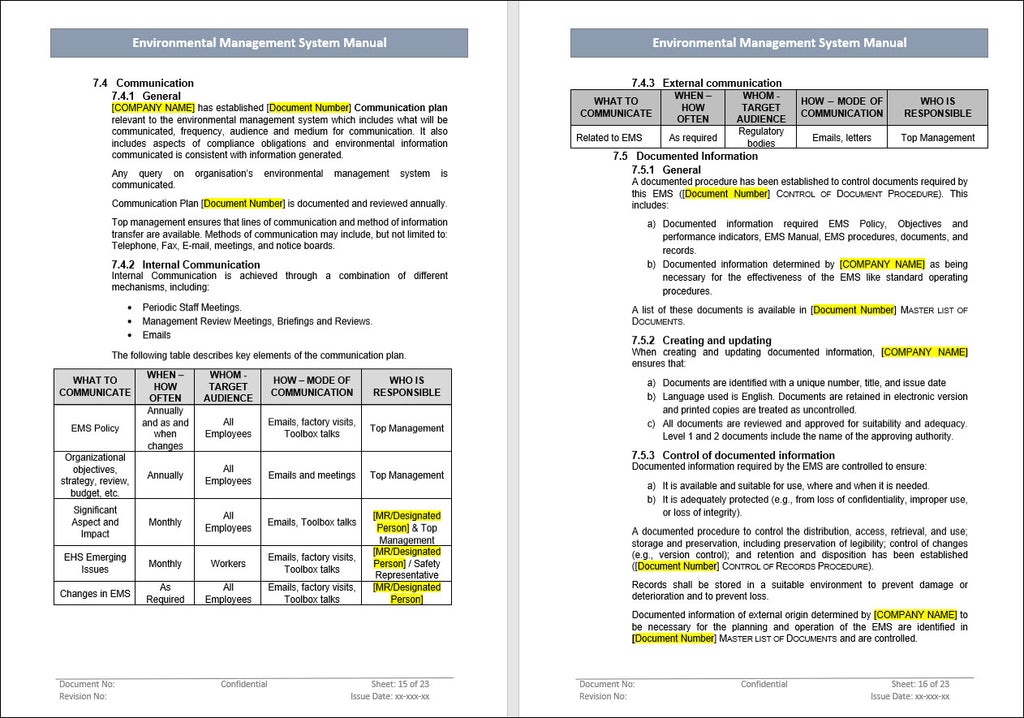Environmental Management System Manual
An environmental management system manual is a document that guides how to establish, operate, and maintain an effective environmental management system. It is based on the requirements of the international standard ISO 14001:2015. The Environmental Management System Manual is intended for use by organizations of all sizes and types committed to continuously improving their environmental performance. It can be used by organizations as a whole or by individual departments or units. The manual can be customized to suit the specific needs of the organization and its environmental objectives. It is essential to read the manual carefully and familiarize yourself with its contents before implementing an environmental management system.

Elements of Environment management system manual
The EMS manual is a document that sets out an organization's EMS in a structured and concise manner. It is a vital reference tool for all EMS personnel. This article provides an overview of the environmental management system manual ISO 14001. An EMS typically includes the following components:
- Environmental policy: A written statement from top management that provides the overall direction and commitment to the EMS.
- Environmental objectives and targets: An organization sets specific goals to achieve its environmental policy.
- An environmental management program: A set of processes and procedures that an organization follows to achieve its environmental objectives and targets.
- Monitoring and Reporting: A system for monitoring and reporting progress toward achieving environmental objectives and targets.
- Auditing: A system for auditing the EMS to ensure it is effective. The EMS manual should be reviewed and updated regularly to remain relevant and accurate.
Benefits of environment management system manual
- It Helps us to keep track of environmental changes.
- It Helps us to identify environmental problems.
- It Helps us to take action to protect the environment.
- It Helps us assess our actions’ impact on the environment.
- It Helps us to improve the quality of our environment.
What is included in the Environment management system manual
This article provides a high-level overview of what is included in an EMS manual. An EMS manual usually contains the following:
- An environmental policy states the organization's commitment to environmental protection and improvement.
- Objectives and targets identify what the organization plans to achieve with its EMS.
- Procedures that describe how the EMS will be implemented, including how environmental aspects will be identified and controlled.
- Record-keeping requirements ensure that data relating to the EMS is collected and maintained.
- Monitoring and evaluation procedures enable the organization to track its progress toward meeting its objectives and targets.
Steps to implement Environmental management system

- EMS policies: The second step in developing and implementing an EMS is to develop environmental policies. The policies should be specific, measurable, achievable, relevant, and time-bound (SMART). They should also be consistent with the company's environmental policy.
- Objectives: After developing policies, objectives must be set. Objectives should support the policies and should be SMART. Once goals have been set, they should be included in the manual.
- Identifying significant environmental aspects and impacts: The next step in developing and implementing an EMS is identifying critical environmental aspects and impacts. Environmental aspects are activities or products that can impact the environment. Impacts are the positive or negative consequences of an action or environmental effect.
- Determining legal and other requirements: The next step in developing and implementing an EMS is to determine legal and other requirements. Legal requirements are required by law, while the company has committed to meeting other conditions.
- Creating environmental programs: After all the above steps have been completed, environmental programs can be created. Programs should be developed for each significant environmental aspect and impact. The plan should address how the company will comply with legal and other requirements and how it will achieve its objectives. The manual needs to include programs.
Instructions to use the template
All yellow indicated numbers in the Environmental Management System Manual need action to be taken. Below are the details:
1. Designation of the person who prepared the document
2. Designation of personnel who reviewed the document
3. Insert Company Name
4. Brief on Products/Services.
5. Mention where the product/service is used
6. Year
7. mention the organization's growth with several countries or client numbers.
8. MR/Designated Person.
9. Describe the actual Scope in which the EMS system will be established or followed if a manufacturing unit manufactures a product and sells and also provides services of repair, but it is implementing EMS only in its manufacturing setup , so that scope would be Manufacture and sale of _____
10. Provide the actual Boundary, i.e., the Address of the Unit
11. If there are any outsourced activities, then include the below
12. Provide the list of outsourced activities below
13. Mention any clause under exception with ISO Clause, Clause Description, Reason for exclusion such as if the design is excluded then ISO Clause is 8.2, Clause Description as Design and Development, Reason for exclusion may be mentioned if the organization does not include
14. Document Number
15. provide portal/location
16. provide a reference like a letter or Org announcement
17. Provide the Revision History of the document
- Revision Number: in the order of 00,01,02, etc
- Date: Revision Date of Document in dd-mmm-yyyy
- Prepared By: Name of the person who prepared the document
- Reviewed By: Name of the person who reviewed the document after Revision
- Approved By: Name of the person who approved the document after Revision
- Description: Describe the Revision
18. Sample details filled can be modified as per the organization’s setup and requirement
19. Insert Company Logo
20. Insert the document number defined as per the document numbering process of the organization
21. Insert the revision number as per the latest number mentioned in Revision History [17]
22. Provide the latest date as per Revision History [17]


